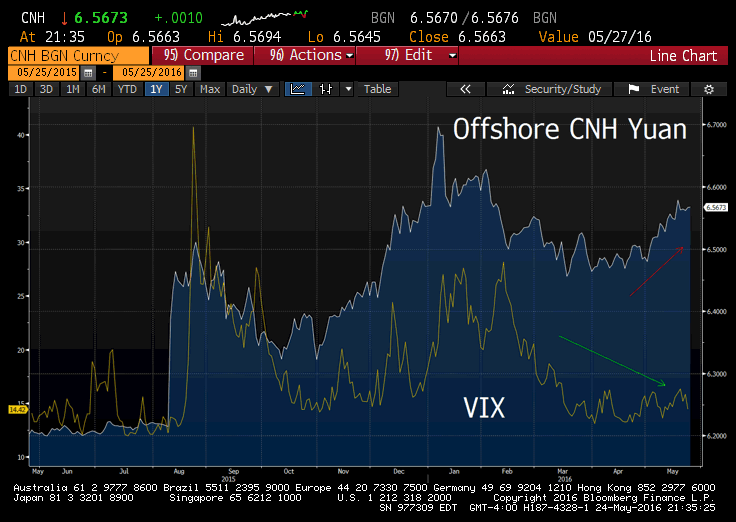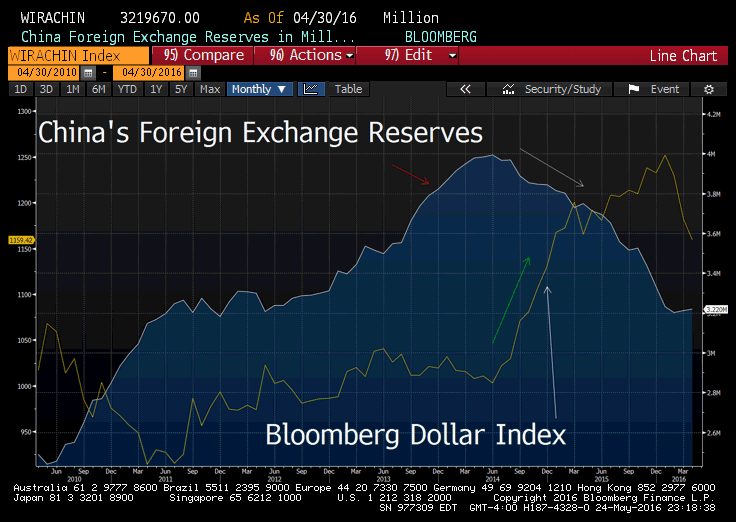Join our Larry McDonald on CNBC’s Trading Nation, Wednesday June 1st, at 2pm.
Pick up our latest Bear Traps Report here.
Breaking News: China Weakens Yuan Fixing to Lowest Level Since March 2011
PBOC weakens yuan fixing by 0.34% to 6.5693/USD.
Offshore yuan -0.04% to 6.5689 in Hong Kong.
Once again, just as the Fed makes a move at a rate hike, the U.S. dollar surge creates side effects that explode in China. We believe the PBOC (China’s Central Bank) wants to ease some of the depreciation pressure before the Fed interest rate decision in June.
As you can see below, over the last year as the yuan weakens, U.S. equity (stock market) volatility has surged.

Pick up our latest Bear Traps Report here.
As we stated last year in our Bear Traps Reports, we believe a bailout in the trillions of dollars is needed to the arrest toxic bad-debt levels dragging down China’s economy.
The 13 Most Dangerous Men on Earth
The most dangerous men on earth might just be those 13 men in a room in Beijing. We are witnessing a planned economy gone rogue, asset prices surging in some places, plunging in others. With all the Communist Party’s talk of giving markets a hand in prices, China’s financial system is still ruled by their highly LEVERAGED state-owned lenders. They swooped in to support the economy several times since 2008. Party leaders can order banks to make new loans or lock in generous forbearance agreements (extend and pretend) on others. The PBOC has also been expanding support for “policy banks” that support government objectives, re-inflating asset bubbles.
Beware of SEOs
From 2006-8, I led a team that made over $100m betting against the subprime mortgage market. Today, we’re seeing the same colossal failure of common sense all over again in China. It’s shadow banking on steroids. Beware, 25% of the (SEOs) state owned enterprises’ outstanding loans are equal to the entire capital base of China’s commercial banks plus loan loss reserves. It’s leverage on leverage, on leverage.
The Coming 20% Devaluation
We believe China’s currency is 20% over-valued. As the Fed moves toward extended liftoff, the U.S. dollar’s surge creates a lot of pain for China, it unearths ugly flaws in their planned economy.
China must weaken its currency in an effort to stop the hemorrhaging of cash leaving the country.
As most know, China lost $800B last year in capital outflows (see the chart below). As the dollar weakened in March, capital outflows in China took a well-needed breather. The Chinese yuan is pegged to the U.S. dollar; thus, a strong U.S. currency makes China’s goods sold around the world much more expensive. After the dollar’s pull back (March – April), China posted their two best export months in the last year. But now the U.S. dollar is on the rise again (see below).
If you are a billionaire in China and you know your currency is dramatically over-valued, you are going to do everything you can to get cash out of the country and into dollars. This explains the record amount of U.S. acquisitions by companies in China, it’s the great cash run out of the country.
Two Ways Out
There are only two ways out for China, a substantial currency or credit devaluation. We think they will choose the former. With NPLs (non-performing loans) at 17% of outstanding credit vs what the PBOC tells us (less than 2%), it’s a mess. Bad loans are 8x to 10x than the bogus official numbers lead us to believe. Ultimately, we believe there is likely $700B to $1T of losses.
$50B Bullets at a $5T Problem
Over the last year, China has been busy throwing $50B bullets at a $5T problem. In recent months, the PBOC’s effectiveness has been seen in the money multiplier, which was at 5.2 in March. The nest result, for every yuan the central bank pumps into the economy generates 4.2 more through the process of loans generating new deposits that then create further loans. Next, the cycle keeps repeating, the bubble keeps inflating.

Bogus Trade Data
There are rising doubts in the market that China has not had a trade surplus since at least February 2013. A reported (bogus) trade surplus of roughly $74B for Q1 2016, we believe in reality was a deficit in the $90-$110B neighborhood.
A look at China’s current balance against net foreign receipts by domestic banks gets you an entirely different picture.
Over a 10 year period, the difference is near $500B. The trade gap is even larger. In 2015, China reported a trade surplus of $330B, while banks reported a trade account deficit of $121B.
If you view the data this way, China’s foreign exchange reserves are in the ugly reality of $2.8T to $3T.
Pick up our latest Bear Traps Report here.



I like it when people get together and share thoughts.
Great website, continue the good work!
I could not refrain from commenting. Exceptionally well written!